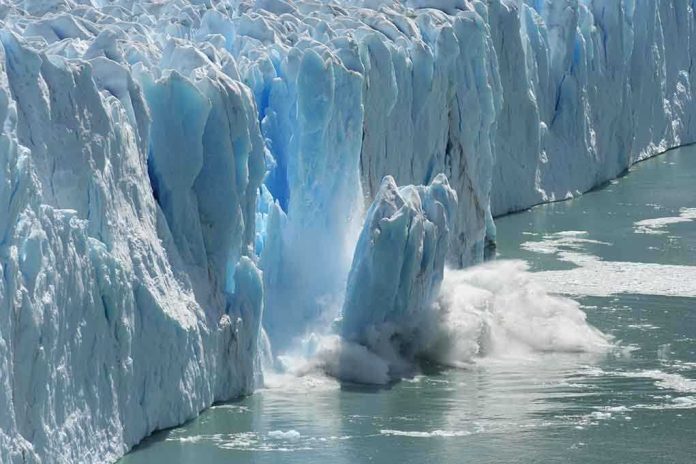
After nearly four decades of defying nature, the world’s largest iceberg A23a is finally succumbing to warmer ocean waters, marking the end of an extraordinary Antarctic giant that has captivated scientists and served as a stark reminder of our changing climate.
Story Overview
- A23a iceberg, twice the size of London, is rapidly disintegrating after 40 years since breaking from Antarctica
- Satellite data shows the massive ice formation has shrunk to less than half its original size in recent months
- Scientists predict complete disappearance within weeks as warm South Atlantic waters accelerate melting
- Large fragments pose significant navigational hazards to shipping while threatening wildlife ecosystems near South Georgia
Four Decades of Antarctic Persistence
A23a calved from Antarctica’s Filchner-Ronne Ice Shelf in 1986, initially carrying a Soviet research station. The massive iceberg remained grounded on the Antarctic seabed for over three decades, making it an exceptionally long-lived ice formation. This remarkable persistence distinguished A23a from typical icebergs that fragment quickly after calving, earning it recognition as one of the most significant polar ice features ever documented.
Scientists began tracking A23a’s movement in 2020 when ocean currents finally dislodged it from its grounded position. The British Antarctic Survey’s RRS Sir David Attenborough intercepted the iceberg in December 2023 for direct sampling, providing crucial data about its composition and deterioration patterns.
Accelerated Breakdown in Warming Waters
Recent satellite imagery from the EU Copernicus Programme reveals A23a has experienced dramatic fragmentation since entering the South Atlantic’s warmer waters. As of September 2025, the iceberg measures approximately 1,770 square kilometers, representing less than half its original size. Large fragments up to 400 square kilometers have broken away, creating smaller icebergs that drift independently through shipping lanes.
Andrew Meijers from the British Antarctic Survey explains the rapid deterioration: “It’s basically rotting underneath. The water is way too warm for it to maintain. It’s constantly melting.” This accelerated breakdown demonstrates how warming ocean temperatures directly impact even the most massive ice formations, providing clear evidence of climate change effects on polar regions.
Wildlife and Maritime Impact Concerns
The iceberg’s trajectory near South Georgia raises significant ecological concerns for penguin and seal populations that depend on stable feeding grounds. Marine biologists worry that A23a’s breakup could disrupt nutrient distribution patterns and alter local ocean chemistry through massive freshwater and mineral dust releases. These changes threaten the delicate balance of one of Antarctica’s most important wildlife sanctuaries.
Maritime authorities closely monitor the situation as large ice fragments create substantial navigational hazards for commercial shipping and fishing operations in the South Atlantic. The unpredictable movement of these massive pieces requires constant satellite surveillance and updated maritime warnings to prevent potential collisions or vessel damage in busy shipping corridors.
Climate Change Documentation Through Ice
A23a’s imminent disappearance serves as powerful documentation of accelerating climate change impacts on polar ice reserves. International scientific collaboration through organizations like the British Antarctic Survey and EU Copernicus Programme provides critical data about iceberg dynamics and melting patterns. This research contributes essential information for understanding long-term sea level rise projections and ocean circulation changes that affect global weather patterns and coastal communities worldwide.
Sources:
World’s largest iceberg is finally about to disappear 40 years after breaking away from Antarctica
Once king of the seas, a giant iceberg is finally breaking up
Once king of the seas, a colossal iceberg is finally breaking up







